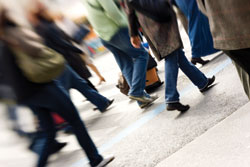
A photo of a crowd of people walking.
Photo: iStock
Leg pain can come from a variety of causes. Your health care professional has specific ways to discover if the cause is P.A.D. Other non-P.A.D. common causes of leg pain may include:
A muscle cramp (also called a charley horse), frequently caused by the following:
- Dehydration or low amounts of potassium, sodium, calcium, or magnesium in the blood
- Medications, such as diuretics, which can cause you to lose too much fluid or minerals
- Muscle fatigue or strain from overuse, too much exercise, or holding a muscle in the same position for a long time
Injuries caused by:
- A torn or overstretched muscle (strain)
- Hairline crack in the bone (stress fracture)
- Inflamed tendon (tendinitis)
- Shin splints—pain in the front of your leg related to overuse or repetitive pounding
Deep vein thrombosis (DVT), which occurs when a blood clot (thrombus) forms in the larger veins of the area. This clot can interfere with blood flow, and it may break off and travel through the bloodstream (embolize). The traveling blood clot (embolus) can lodge in the brain, lungs, heart, or other area, severely damaging that organ.
DVT was in the news with the death of NBC correspondent David Bloom in April 2003. The 39-year-old co-anchor of Weekend Today died from a pulmonary embolism—a blood clot that moved from the leg to the lung—caused by DVT.
Bloom was reporting from Iraq where he was spending long hours in a tank allowing him limited mobility. In addition, he had recently been on several long plane flights from New York to Kuwait, and had a genetic pre-disposition to blood clots.
- Infection of the bone (osteomyelitis) or skin and soft tissue (cellulitis)
- Inflammation of the leg joints by arthritis or gout
- Nerve damage—common in diabetics, smokers, and alcoholics (symptoms include numbness, tingling, or a sensation of pins-and-needles)
- Varicose veins—swollen and twisted veins that are visible just under the surface of the skin
- Spinal stenosis—narrowing in the spine, causing pressure on the nerves and spine, with resulting numbness and pain
- Lumbar disease
- Osteoarthritis
QUESTIONS TO ASK YOUR HEALTH CARE PROVIDER
- Does my medical history raise my risk for P.A.D.?
- Do I need to do anything about my blood glucose, blood pressure, or cholesterol?
- Which screening tests or exams are right for me?
- If I have P.A.D., what steps should I take to treat it?
- What steps can I take to reduce my risk for heart attack and stroke?
- What can I do to quit smoking?
To Find Out More
For more information about P.A.D. and to download free education materials, visit:
- MedlinePlus: www.nlm.nih.gov/medlineplus/
peripheralarterialdisease.html - Stay in Circulation: Take Steps to Learn About P.A.D., www.aboutpad.org
- NHLBI Diseases and Conditions Index: www.nhlbi.nih.gov/health/dci/
Diseases/pad/pad_what.html - P.A.D. Coalition: www.padcoalition.org
